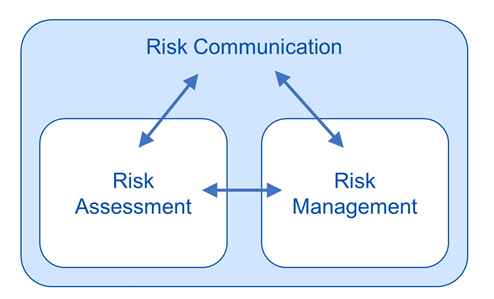Risk Messaging Guidance
On this page:
Risk messaging is an interactive exchange of information to help communicate potential hazards to people, property, or community between risk assessors, risk managers, communities, media, interest groups, and the public. Effective risk messaging and public engagement builds trust and often leads to better decisions about risk.
The purpose of risk messaging is:
- to help potentially affected people understand the processes of risk assessment and management,
- to facilitate science-based perceptions of the hazards, and
- to participate in making decisions about how the risk should be managed.
Risk communication should:
- put a particular risk in context,
- compare risks appropriately,
- include advice about risk reduction behavior, and
encourage a dialogue between the sender and receiver of the message.

Effective risk messaging is based on an understanding that risk means different things to different people. This is why it is so important to use the proper materials and have all the latest information when engaging a risk manager or stakeholders who may be relaying this information and facilitating discussions where stakeholder participation in the decision-making process is key. It fundamentally helps the risk manager understand perceptions of risk and helps establish a constructive relationship throughout the process.
Risk messaging tools can be written, verbal, or visual statements containing information about risk. The “Guidance Documents” tab provides links to approaches for effectively communicating these risk. The “Communication Examples” tab provides links to example materials.
Guidance Documents
Below are links to relevant guidance documents sorted into four categories: general, microbial risks, Superfund communities, and Tribal communities.
Note: Also refer to the citizen guidance page for additional materials.
RISK Messaging Examples
These documents provide examples of risk messaging resources for different stressors and exposures.
| Category | Title | Year |
|---|---|---|
| Biological, Coronavirus (COVID-19) | EPA’s Coronavirus (COVID-19) Website | 2020 |
| Multi-media, Multi-stressor | Risk Assessment Guidelines: Citizen Guides | 2020 |
| Air, Pollutants | EPA Air Now Website | 2020 |
| Air, Wildfires | Smoke-Ready Toolbox for Wildfires | 2019 |
| Air, Wildfires | Wildfires Website | 2019 |
| Radiation | Radiation Protection, Protective Action Guide (PAG) Public Communication Resources | 2019 |
| Water, Recreation | EPA's Beach Advisory and Closing On-line Notification (BEACON) Database | 2020 |
| Water, Drinking | Water Utility Communication During Emergency Response | 2019 |
| Water, Drinking | Basic Information about Lead in Drinking Water | 2019 |
